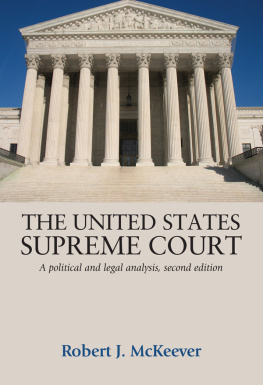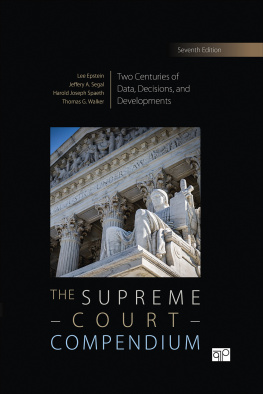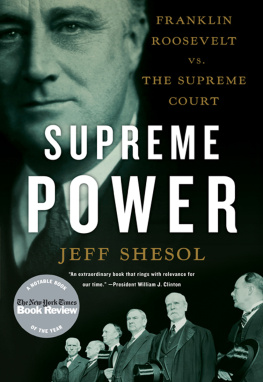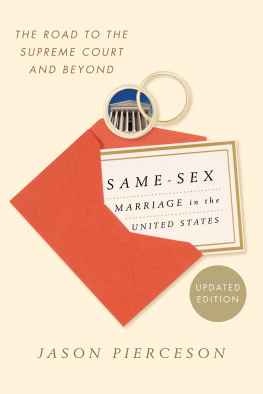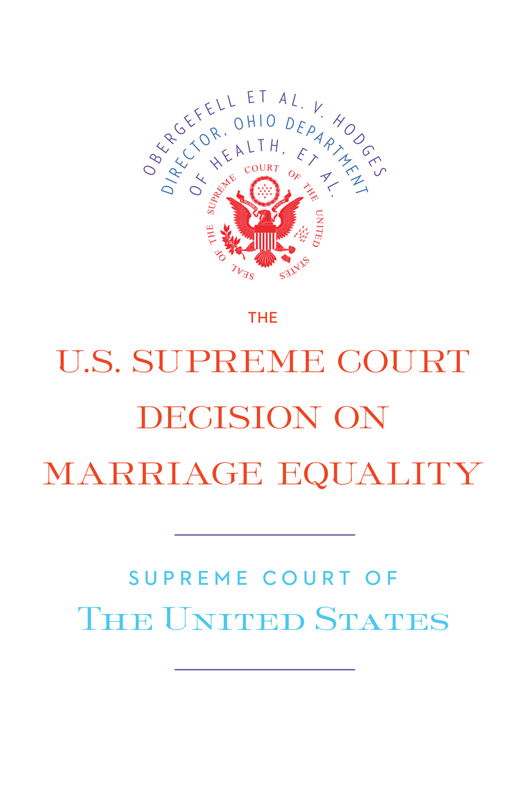THE
U.S. SUPREME COURT
DECISION ON
MARRIAGE EQUALITY
No copyright is claimed on works of the United States Government
First Melville House Printing: October 2015
Melville House Publishing
46 John Street
Brooklyn, NY 11201
and
8 Blackstock Mews
Islington
London N4 2BT
mhpbooks.com facebook.com/mhpbooks @melvillehouse
ISBN: 978-1-61219-530-8
eBook ISBN: 978-1-61219-531-5
A catalog record for this book is available from the Library of Congress
v3.1
CONTENTS
SYLLABUS
SUPREME COURT OF
THE UNITED STATES
SYLLABUS
OBERGEFELL ET AL . v. HODGES, DIRECTOR,
OHIO DEPARTMENT OF HEALTH, ET AL .
CERTIORARI TO THE UNITED STATES COURT OF APPEALS
FOR THE SIXTH CIRCUIT
NO. 14556. ARGUED APRIL 28, 2015DECIDED JUNE 26, 2015
Michigan, Kentucky, Ohio, and Tennessee define marriage as a union between one man and one woman. The petitioners, 14 same-sex couples and two men whose same-sex partners are deceased, filed suits in Federal District Courts in their home States, claiming that respondent state officials violate the Fourteenth Amendment by denying them the right to marry or to have marriages lawfully performed in another State given full recognition. Each District Court ruled in petitioners favor, but the Sixth Circuit consolidated the cases and reversed.
Held: The Fourteenth Amendment requires a State to license a marriage between two people of the same sex and to recognize a marriage between two people of the same sex when their marriage was lawfully licensed and performed out-of-State. Pp. 328.
(a) Before turning to the governing principles and precedents, it is appropriate to note the history of the subject now before the Court. Pp. 310.
(1) The history of marriage as a union between two persons of the opposite sex marks the beginning of these cases. To the respondents, it would demean a timeless institution if marriage were extended to same-sex couples. But the petitioners, far from seeking to devalue marriage, seek it for themselves because of their respectand needfor its privileges and responsibilities, as illustrated by the petitioners own experiences. Pp. 36.
(2) The history of marriage is one of both continuity and change. Changes, such as the decline of arranged marriages and the abandonment of the law of coverture, have worked deep transformations in the structure of marriage, affecting aspects of marriage once viewed as essential. These new insights have strengthened, not weakened, the institution. Changed understandings of marriage are characteristic of a Nation where new dimensions of freedom become apparent to new generations.
This dynamic can be seen in the Nations experience with gay and lesbian rights. Well into the 20th century, many States condemned same-sex intimacy as immoral, and homosexuality was treated as an illness. Later in the century, cultural and political developments allowed same-sex couples to lead more open and public lives. Extensive public and private dialogue followed, along with shifts in public attitudes. Questions about the legal treatment of gays and lesbians soon reached the courts, where they could be discussed in the formal discourse of the law. In 2003, this Court overruled its 1986 decision in Bowers v. Hardwick, 478 U. S. 186, which upheld a Georgia law that criminalized certain homosexual acts, concluding laws making same-sex intimacy a crime demea[n] the lives of homosexual persons. Lawrence v. Texas, 539 U. S. 558, 575. In 2012, the federal Defense of Marriage Act was also struck down. United States v. Windsor, 570 U. S. ___. Numerous same-sex marriage cases reaching the federal courts and state supreme courts have added to the dialogue. Pp. 610.
(b) The Fourteenth Amendment requires a State to license a marriage between two people of the same sex. Pp. 1027.
(1) The fundamental liberties protected by the Fourteenth Amendments Due Process Clause extend to certain personal choices central to individual dignity and autonomy, including intimate choices defining personal identity and beliefs. See, e.g., Eisenstadt v. Baird, 405 U. S. 438, 453; Griswold v. Connecticut, 381 U. S. 479, 484486. Courts must exercise reasoned judgment in identifying interests of the person so fundamental that the State must accord them its respect. History and tradition guide and discipline the inquiry but do not set its outer boundaries. When new insight reveals discord between the Constitutions central protections and a received legal stricture, a claim to liberty must be addressed.
Applying these tenets, the Court has long held the right to marry is protected by the Constitution. For example, Loving v. Virginia, 388 U. S. 1, 12, invalidated bans on interracial unions, and Turner v. Safley, 482 U. S. 78, 95, held that prisoners could not be denied the right to marry. To be sure, these cases presumed a relationship involving opposite-sex partners, as did Baker v. Nelson, 409 U. S. 810, a one-line summary decision issued in 1972, holding that the exclusion of same-sex couples from marriage did not present a substantial federal question. But other, more instructive precedents have expressed broader principles. See, e.g., Lawrence, supra, at 574. In assessing whether the force and rationale of its cases apply to same-sex couples, the Court must respect the basic reasons why the right to marry has been long protected. See, e.g., Eisenstadt, supra, at 453454. This analysis compels the conclusion that same-sex couples may exercise the right to marry. Pp. 1012.
(2) Four principles and traditions demonstrate that the reasons marriage is fundamental under the Constitution apply with equal force to same-sex couples. The first premise of this Courts relevant precedents is that the right to personal choice regarding marriage is inherent in the concept of individual autonomy. This abiding connection between marriage and liberty is why Loving invalidated interracial marriage bans under the Due Process Clause. See 388 U. S., at 12. Decisions about marriage are among the most intimate that an individual can make. See Lawrence, supra, at 574. This is true for all persons, whatever their sexual orientation.
A second principle in this Courts jurisprudence is that the right to marry is fundamental because it supports a two-person union unlike any other in its importance to the committed individuals. The intimate association protected by this right was central to Griswold v. Connecticut, which held the Constitution protects the right of married couples to use contraception, 381 U. S., at 485, and was acknowledged in Turner, supra, at 95. Same-sex couples have the same right as opposite-sex couples to enjoy intimate association, a right extending beyond mere freedom from laws making same-sex intimacy a criminal offense. See Lawrence, supra, at 567.
A third basis for protecting the right to marry is that it safeguards children and families and thus draws meaning from related rights of childrearing, procreation, and education. See, e.g., Pierce v. Society of Sisters, 268 U. S. 510. Without the recognition, stability, and predictability marriage offers, children suffer the stigma of knowing their families are somehow lesser. They also suffer the significant material costs of being raised by unmarried parents, relegated to a more difficult and uncertain family life. The marriage laws at issue thus harm and humiliate the children of same-sex couples. See


